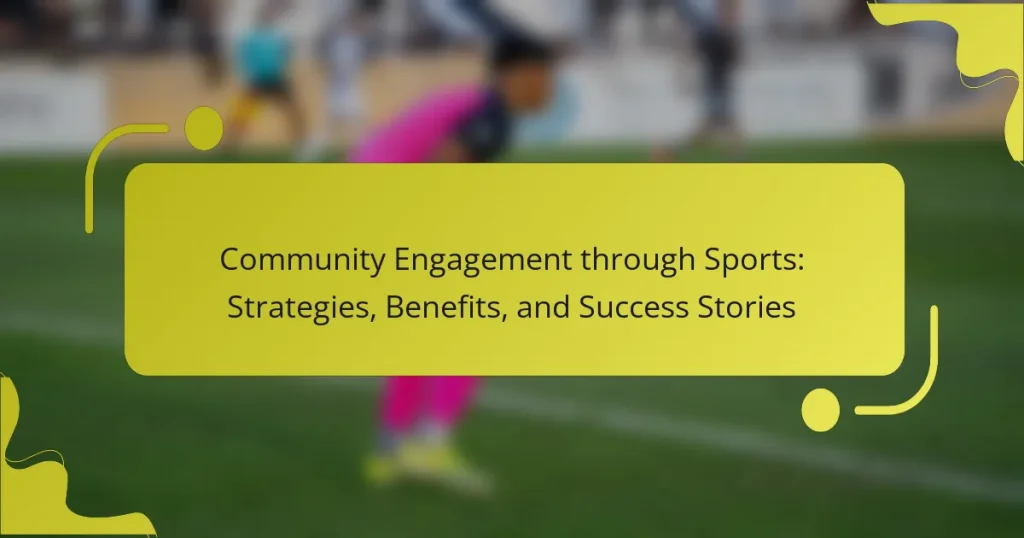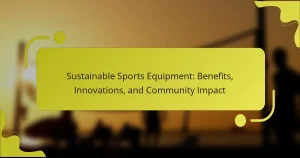Community engagement through sports strengthens social connections and fosters a sense of belonging. This article explores effective strategies for promoting participation, highlights the benefits of community sports programmes, and shares successful case studies from around the world. By addressing challenges and emphasizing inclusivity, communities can enhance their sports initiatives for greater impact.
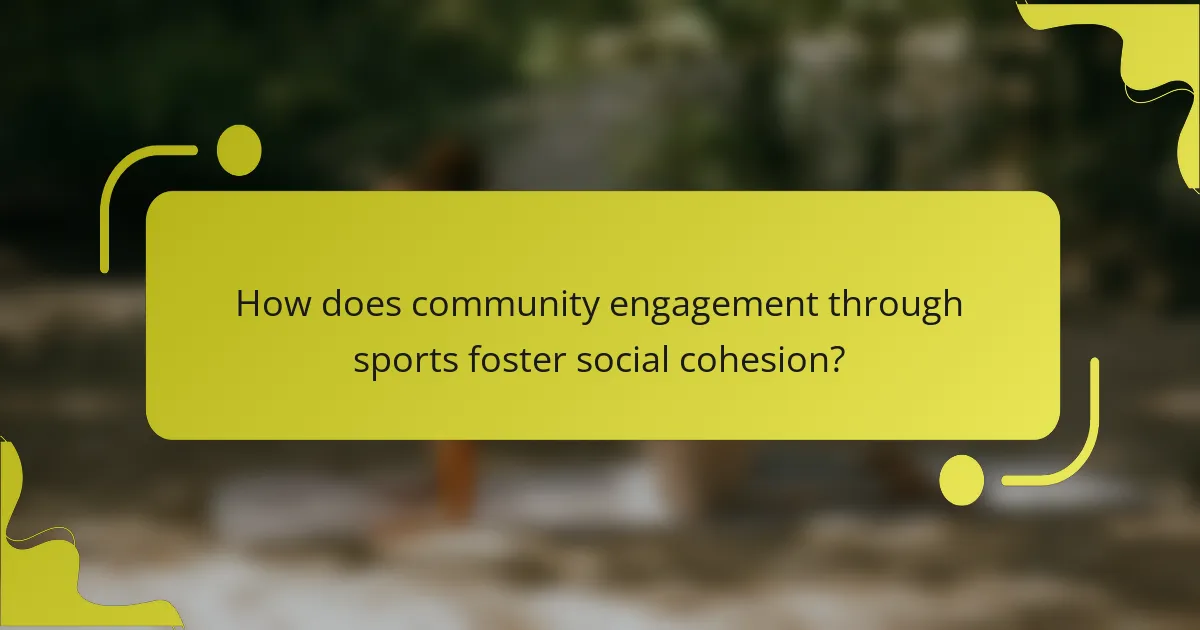
How does community engagement through sports foster social cohesion?
Community engagement through sports fosters social cohesion by promoting teamwork, communication, and shared goals. Sports activities create opportunities for diverse groups to interact, breaking down social barriers. Participating in local leagues or community events encourages collaboration and mutual respect among individuals. As a result, communities become more unified, leading to a stronger sense of belonging and collective identity. Programmes that include youth mentorship through sports further enhance these benefits, providing role models and fostering positive relationships.
What are the psychological benefits of participating in sports communities?
Participating in sports communities offers significant psychological benefits, including enhanced social connections, increased self-esteem, and reduced stress levels. Engaging in team activities fosters a sense of belonging and support. This communal experience can alleviate feelings of loneliness and promote mental well-being. Furthermore, the shared goals and achievements in sports can boost individual confidence and resilience.
Which demographics benefit most from sports-based community initiatives?
Youth, low-income families, and marginalised communities benefit most from sports-based community initiatives. These demographics often lack access to resources and opportunities, making sports a vital tool for engagement and development.
Programmes targeting youth can improve physical health, foster teamwork, and build leadership skills. Low-income families may find enhanced social cohesion and support networks through participation. Marginalised communities can gain visibility and empowerment, promoting inclusivity and social change.
Research indicates that youth involved in sports are less likely to engage in risky behaviours and more likely to pursue academic success. Additionally, community initiatives can lead to improved mental health outcomes across these demographics.

What strategies enhance community participation in sports activities?
Engaging the community in sports activities enhances participation through targeted strategies. Effective approaches include organising inclusive events, fostering partnerships with local organisations, and utilising social media for outreach.
Community sports events should cater to diverse interests and skill levels, ensuring everyone feels welcome. Collaborating with schools, businesses, and non-profits can amplify resources and reach. Social media platforms can effectively promote events and create excitement, drawing in participants who might not otherwise engage.
As a result, these strategies can lead to increased attendance, stronger community bonds, and improved overall health outcomes. Successful case studies demonstrate that communities can thrive when sports activities are accessible and well-promoted.
How can local organisations effectively promote sports events?
Local organisations can effectively promote sports events by engaging the community through targeted strategies. Utilising social media campaigns, local partnerships, and grassroots outreach fosters excitement and participation.
Community engagement enhances visibility and attendance. For instance, collaborating with schools and local businesses creates a supportive network. Organising pre-event activities, such as workshops or meet-and-greets, builds anticipation and strengthens community ties.
Success stories from previous events demonstrate the benefits of these strategies. Events that involved local influencers or athletes often saw increased turnout and media coverage. Engaging storytelling around the event’s purpose can also resonate with potential attendees.
In summary, leveraging community connections and creating interactive experiences are key to successful sports event promotion.
What role do schools play in fostering sports engagement within communities?
Schools play a crucial role in fostering sports engagement within communities by providing facilities, organising events, and promoting teamwork. They serve as hubs for physical activity, encouraging students to participate in various sports. This involvement enhances community spirit and social cohesion. Schools often collaborate with local organisations to host tournaments and workshops, increasing accessibility to sports. As a result, they cultivate a culture of health and fitness, benefiting both students and the broader community.
Which technology platforms facilitate community sports engagement?
Technology platforms that facilitate community sports engagement include social media, mobile apps, and online forums. These platforms enhance communication, organisation, and participation in local sports activities. For example, platforms like Meetup and Strava allow users to connect with others, share events, and track progress. Additionally, community-focused apps can provide scheduling tools and foster team collaboration. These technologies empower communities to build stronger connections through shared sports experiences.

What are the measurable impacts of sports on community development?
Sports significantly enhance community development by fostering social cohesion, improving health, and boosting local economies. Engaging in sports creates networks of support and collaboration among residents. For instance, community sports programmes can reduce crime rates by providing positive activities for youth. Additionally, local events attract visitors, stimulating economic growth. Research indicates that neighbourhoods with active sports initiatives report higher levels of community satisfaction and involvement.
How do sports initiatives improve local economies?
Sports initiatives significantly enhance local economies by fostering community engagement, boosting local businesses, and creating job opportunities. These programmes often lead to increased foot traffic in neighbourhoods, which benefits restaurants, shops, and service providers. For instance, hosting sporting events can attract visitors, generating revenue for hotels and local attractions.
Moreover, community sports programmes promote health and wellness, reducing healthcare costs in the long run. They can also strengthen social ties, leading to more cohesive neighbourhoods that are attractive to potential investors. As a result, cities with strong sports initiatives often see improved infrastructure and enhanced quality of life for residents.
Success stories demonstrate these benefits, such as cities that have revitalised areas through sports complexes or local leagues, creating a vibrant community atmosphere while stimulating economic growth.
What metrics are used to evaluate the success of community sports programmes?
Community sports programmes are evaluated using several key metrics. These include participation rates, retention rates, community satisfaction surveys, health outcomes, and social impact assessments.
| Metric | Description |
|—————————-|—————————————————–|
| Participation Rates | Number of individuals actively involved in programmes |
| Retention Rates | Percentage of participants who continue over time |
| Community Satisfaction | Feedback from surveys measuring enjoyment and value |
| Health Outcomes | Improvements in physical health metrics |
| Social Impact Assessments | Evaluation of community cohesion and engagement |

What are some successful case studies of community engagement through sports?
Community engagement through sports has led to numerous successful case studies. One notable example is the “Sport for Development” initiative in South Africa, which uses soccer to promote social cohesion and youth empowerment. This programme has engaged over 10,000 participants, fostering teamwork and life skills.
Another case is the “Playworks” programme in the United States, which enhances recess experiences in schools. By training coaches, it has improved playground behaviour and increased student engagement, positively impacting academic performance.
In Brazil, the “Street Football World” project empowers marginalised youth through soccer, providing mentorship and community support. This initiative has successfully reduced youth violence in participating neighbourhoods.
Lastly, the “Community Sports Network” in Australia connects local clubs with schools, promoting physical activity and community spirit. It has increased participation rates by 30%, demonstrating the effectiveness of collaboration in enhancing community engagement through sports.
Which innovative programmes have shown significant results in enhancing community ties?
Community engagement through sports has seen innovative programmes yield significant results in enhancing community ties. Programmes like “Sport for All” and “Youth Sports Initiative” have effectively fostered inclusion and collaboration. These initiatives often incorporate local sports events, mentorship opportunities, and skill development workshops, resulting in improved social cohesion and community spirit. For instance, studies show that neighbourhoods with active sports programmes report a 30% increase in community interaction.
How have international sports events influenced local communities?
International sports events significantly influence local communities by fostering engagement, enhancing social cohesion, and stimulating economic growth. These events create opportunities for community participation, uniting diverse groups through shared experiences.
One key strategy is local volunteering, where residents contribute to event organisation, fostering a sense of ownership and pride. As a result, these activities can strengthen community bonds and promote inclusivity.
Economic benefits also arise, as local businesses often experience increased traffic and sales during such events. For instance, a study indicated that host cities see a 20% rise in tourism-related revenue during international sports events.
Success stories include cities that have transformed their infrastructure and community programmes post-event, creating lasting legacies that benefit residents long after the event concludes.
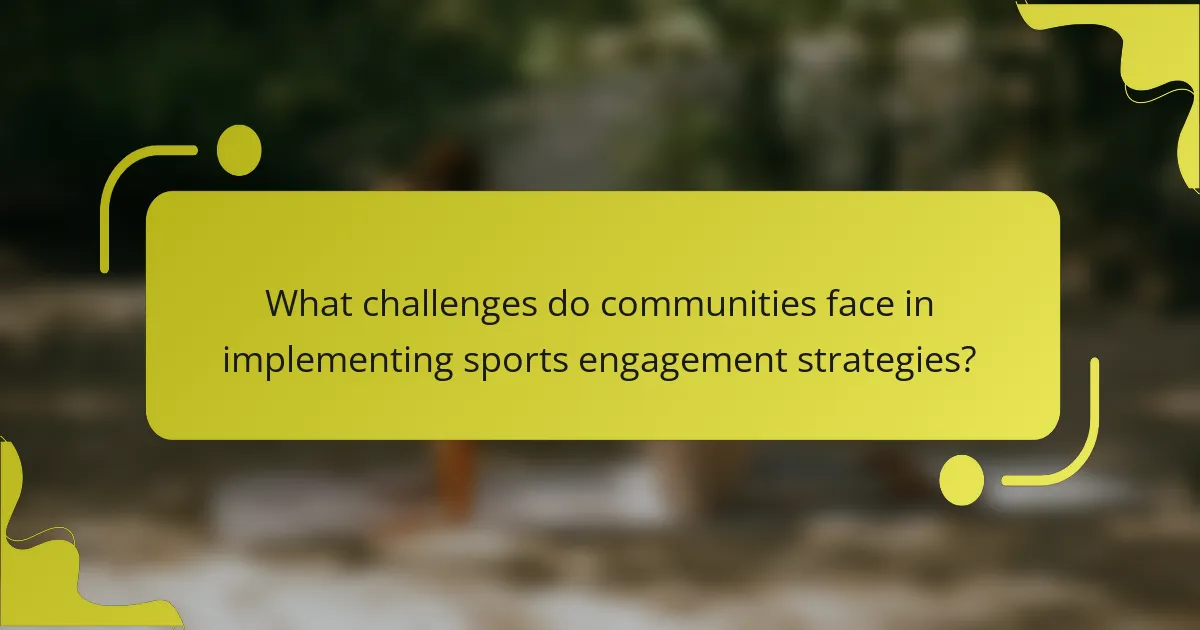
What challenges do communities face in implementing sports engagement strategies?
Communities face several challenges in implementing sports engagement strategies, including funding limitations, lack of facilities, and insufficient community interest. These obstacles can hinder the development of effective programmes. Additionally, disparities in access to resources can create unequal opportunities for participation. Engaging diverse populations requires tailored approaches that address specific community needs and preferences. Collaborating with local organisations can enhance outreach and increase participation rates, ultimately leading to more successful sports engagement initiatives.
How can communities overcome barriers to participation in sports?
Communities can overcome barriers to participation in sports by fostering inclusive environments, providing accessible facilities, and encouraging diverse programmes. Engaging local leaders and organisations increases awareness and support. Collaborative efforts can lead to innovative solutions, such as community sports days or outreach programmes targeting underrepresented groups. These strategies enhance social cohesion and promote physical well-being.
What are the common misconceptions about community sports initiatives?
Common misconceptions about community sports initiatives include the belief that they only benefit athletes, overlook diverse populations, and require significant funding. Many think these programmes fail to create lasting change, but evidence shows they foster community cohesion and improve public health. Additionally, some assume that success is solely measured by competition outcomes, ignoring the value of participation and social interaction.
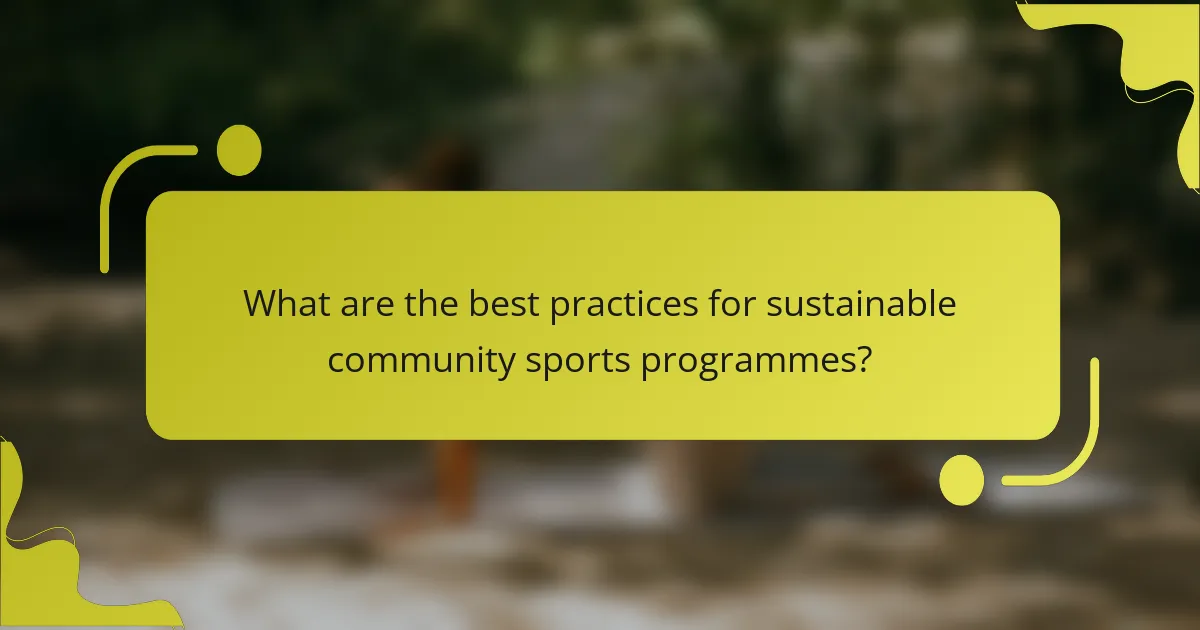
What are the best practices for sustainable community sports programmes?
To create sustainable community sports programmes, focus on inclusivity, collaboration, and resource management. Engaging local stakeholders fosters a sense of ownership and ensures diverse participation. Establish partnerships with schools, organisations, and businesses to enhance resources and visibility. Implement environmentally conscious practices, such as using sustainable materials and promoting eco-friendly transportation. Regular evaluation of programme impact helps identify areas for improvement and ensures long-term success.
How can community leaders ensure long-term engagement in sports?
Community leaders can ensure long-term engagement in sports by fostering inclusive environments, promoting diverse activities, and building strong partnerships. Engaging local stakeholders and creating sustainable programmes enhances participation. For example, regular community events and feedback mechanisms can adapt offerings to meet evolving interests. Additionally, leveraging success stories from local athletes can inspire ongoing involvement.
What expert tips can enhance the effectiveness of sports-based community initiatives?
Expert tips to enhance sports-based community initiatives include fostering partnerships, prioritising inclusivity, and leveraging local resources. Engaging diverse community members boosts participation and strengthens connections. Setting clear goals allows for measurable impacts, while sharing success stories inspires further involvement. Regular feedback from participants ensures initiatives remain relevant and effective.
